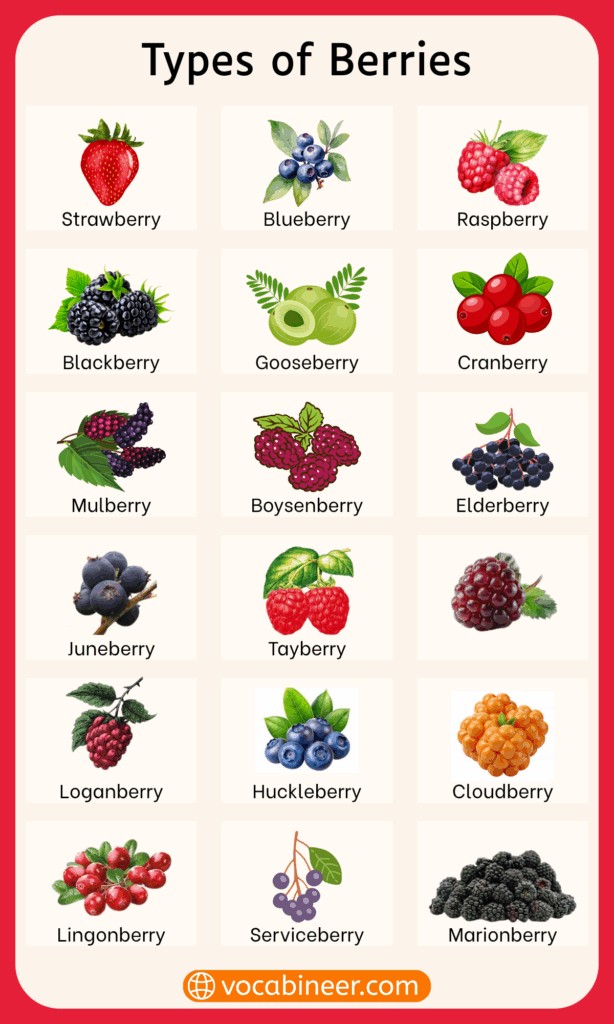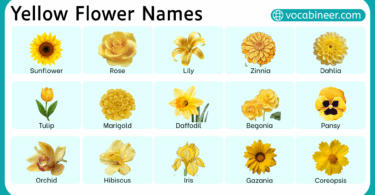Berries vary widely in shape, color, and taste. Learning the types of berries in English with pictures helps describe and identify them in cooking, health food, or gardening contexts. Some are sweet and common, while others are rare or tangy. You’ll come across tropical, wild, and nutrient-rich kinds. Knowing different berry types helps in food talk, recipe reading, or fruit shopping.
In This Page
Different Types of Berries in English
Berries differ in how they grow, taste, and where they’re used. Let’s explore edible berry names used in English.
Common Berries Eaten Around the World
These are the berries people eat daily, whether fresh or cooked. They’re used in meals, drinks, and snacks.
Strawberries
Strawberries are red, heart-shaped berries with a sweet flavor. They’re eaten raw or added to cakes and jams.
Blueberries
Blueberries are small, round, and deep blue. They’re rich in antioxidants and used in muffins and smoothies.
Raspberries
Raspberries are red or black and hollow inside. They taste tart-sweet and are used in syrups and yogurts.
Blackberries
Blackberries are dark, juicy berries with a sweet flavor. They are good for jams and fresh eating.
Cranberries
Cranberries are small, red, and very tart. They are usually cooked into sauces or dried for snacks.
Gooseberries
Gooseberries are green or purple with a sour bite. Often used in pies, chutneys, or eaten with sugar.
Elderberries
Elderberries are dark purple and must be cooked before eating. They’re used in syrups and herbal teas.
Mulberries
Mulberries grow on trees and resemble blackberries. They are sweet and used in jams and wines.

List of Tropical and Exotic Berries
These berries grow in warm climates and are known for bold flavors. Many of them are also used in health food.
Acai Berries
Acai berries are dark purple and grow in Brazil. They’re blended in health bowls and energy drinks.
Goji Berries
Goji berries are orange-red and chewy. Popular in Chinese medicine and eaten dried or in teas.
Maqui Berries
Maqui berries are deep purple and native to South America. They’re used in powders and juices.
Camu Camu
Camu camu is small and bitter. It’s high in vitamin C and used in supplements.
Miracle Berries
Miracle berries change sour tastes to sweet. They’re used to alter taste temporarily.
Cloudberries
Cloudberries are golden-orange and rare. Found in cold climates, they are used in Nordic cuisine.
Jabuticaba
Jabuticaba grows on tree trunks. It’s dark-skinned and tastes like grapes.
Wild and Forest-Grown Berries Names
Some berries grow in forests and wild areas. Many are hand-picked and used in local or traditional dishes.
Huckleberries
Huckleberries are small, purple berries. They resemble blueberries but taste wilder and more intense.
Chokeberries
Chokeberries are very tart and rich in antioxidants. Often made into juices or wines.
Serviceberries
Serviceberries are sweet and grow on shrubs. They’re eaten raw or baked in pies.
Barberries
Barberries are red and tangy. Used in Persian rice dishes and pickled condiments.
Lingonberries
Lingonberries are tart red berries. Common in Scandinavian foods and often made into jams.
Boysenberries
Boysenberries are large, dark berries from blackberry-raspberry hybrids. Used in desserts.
Dewberries
Dewberries grow close to the ground. They look like small blackberries and taste similarly sweet.
Edible Berries Used in Cooking and Desserts
These types of berries often appear in baked goods and sauces. Some add sweetness, others bring tang to recipes.
Red Currants
Red currants are bright red and tart. Used in sauces and garnishes.
White Currants
White currants are pale and sweeter than red ones. Great for desserts.
Black Currants
Black currants are strong-flavored and dark. Used in syrups and candies.
Juniper Berries
Juniper berries are used to flavor gin and meats. They have a piney taste and are not eaten raw.
Names of Non-Toxic Berries from Plants and Shrubs
These berries grow naturally and are safe to eat. Some are used in native or herbal traditions.
Sea Buckthorn
Sea buckthorn berries are orange and tangy. Used in oils, juices, and skincare.
Buffalo Berries
Buffalo berries are tart red berries found in North America. Eaten cooked or dried.
Hackberries
Hackberries are sweet and crunchy. Eaten fresh or ground into meal by native cultures.
Berries That Are Not True Berries
Even though we call them berries, some don’t meet the scientific meaning. Let’s check a few of them.
Strawberries
Strawberries form from multiple ovaries and are not botanical berries.
Raspberries
Raspberries are aggregates made of many small drupelets.
Blackberries
Blackberries are similar to raspberries and not true berries either.
Health-Rich Berries Types Packed with Nutrients
Many berries support health with nutrients. This includes antioxidants, fiber, and key vitamins like C.
Antioxidant Berries
Blueberries, elderberries, and maqui help fight cell damage from oxidation.
Vitamin C-Rich Berries
Camu camu, acerola, and goji berries are very high in vitamin C.
Fiber-Loaded Berry Types
Blackberries, raspberries, and currants provide dietary fiber for digestion.
FAQs About Berry Types
The most common ones include strawberries, blueberries, raspberries, blackberries, and cranberries. These are widely used in food and snacks.
Not all. While berries like blueberries and strawberries are safe raw, elderberries must be cooked before eating.
Fruits like bananas, kiwis, and grapes are considered true berries in botanical terms—not strawberries or raspberries.
Blueberries, acai, maqui, and goji berries are packed with antioxidants and nutrients that support body functions.
Rare edible berries include cloudberries, miracle berries, and jabuticaba, usually found in specific regions or climates.
Read More




